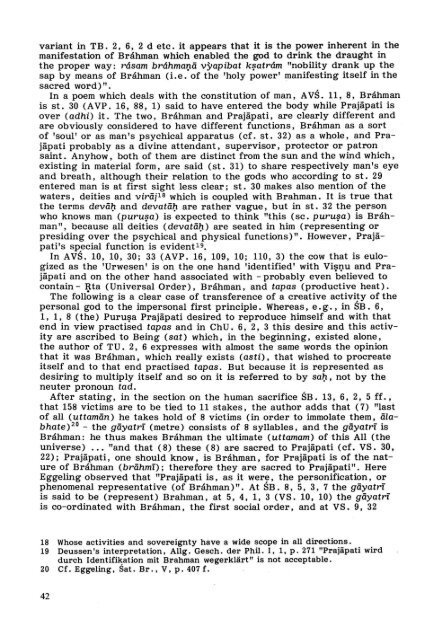Prajapati's relations with Brahman, Brhaspati and Brahma - DWC
Prajapati's relations with Brahman, Brhaspati and Brahma - DWC
Prajapati's relations with Brahman, Brhaspati and Brahma - DWC
You also want an ePaper? Increase the reach of your titles
YUMPU automatically turns print PDFs into web optimized ePapers that Google loves.
variant in TB. 2, 6, 2 d etc. it appears that it is the power inherent in the<br />
manifestation of Bráhman which enabled the god to drink the draught in<br />
the proper way: rásam bráhmavä vyapibat k~atrám "nobility drank up the<br />
sap by means of Bráhman (i.e. of the 'holy power' manifesting itself in the<br />
sacred word)". .<br />
In a poem which deals <strong>with</strong> the constitution of man, A VS. 11, 8, Bráhman<br />
is st. 30 (AVP. 16, 88, 1) said to have entered the body while Prajäpati is<br />
over (adhi) it. The two, Bráhman <strong>and</strong> Prajäpati, are clearly different <strong>and</strong><br />
are obviously considered to have different functions, Bráhman as a sort<br />
of 'soul' or as man's psychical apparatus (cf. st. 32) as a whoie, <strong>and</strong> Prajäpati<br />
probably as a divine attendant, supervisor, protector or patron<br />
saint. Anyhow, both of them are distinct from the sun <strong>and</strong> the wind which,<br />
existing in material form, are said (st. 31) to share respectively man's eye<br />
<strong>and</strong> breath, although their relation to the gods who according to st. 29<br />
entered man is at first sight less clear; st. 30 makes also mention of the<br />
waters, deities <strong>and</strong> viräj18 which is coupled <strong>with</strong> <strong><strong>Brahma</strong>n</strong>. It is true that<br />
the terms devä~ <strong>and</strong> devatä~ are rat her vague, but in st. 32 the person<br />
who knows man (puru~a) is expected to think "this (sc. puru~a) is Bráhman",<br />
because all deities (devatä~) are seated in him (representing or<br />
presiding over the psychical <strong>and</strong> physical functions )". However, Prajäpati's<br />
special function is evident 19 •<br />
In AVS. 10, 10, 30; 33 (AVP. 16, 109, 10; 110, 3) the cow that is eulogized<br />
as the 'Urwesen' is on the one h<strong>and</strong> 'identified' <strong>with</strong> Vililt;lU <strong>and</strong> Prajäpati<br />
<strong>and</strong> on the other h<strong>and</strong> associated <strong>with</strong> - probably even believed to<br />
contain - I.tta (UniversalOrder), Bráhman, <strong>and</strong> tap as (productive heat).<br />
The following is a clear case of transference of a creative activity of the<br />
personal god to the impersonal first principle. Whereas, e. g. , in SB. 6,<br />
1, 1, 8 (the) Purulila Prajäpati desired to reproduce himself <strong>and</strong> <strong>with</strong> that<br />
end in view practised tapas <strong>and</strong> in ChU. 6, 2, 3 this desire <strong>and</strong> this activity<br />
are ascribed to Being (sat) which, in the beginning , existed alone,<br />
the author of TU. 2, 6 expresses <strong>with</strong> almost the same words the opinion<br />
that it was Bráhman, which really exists (asli) , that wished to procreate<br />
itself <strong>and</strong> to that end practised tap as . But because it is represented as<br />
desiring to multiply itself <strong>and</strong> so on it is referred to by sa~, not by the<br />
neuter pronoun tad.<br />
Af ter stating, in the section on the human sacrifice SB. 13, 6, 2, 5 ff. ,<br />
that 158 victims are to be tied to 11 stakes, the author adds that (7) "last<br />
of all (uttamän) he takes hold of 8 victims (in order to immolate them, älabhate)20<br />
- the gäyatrï (metre) consists of 8 syllabies, <strong>and</strong> the gäyatrï is<br />
Bráhman: he thus makes Bráhman the ultimate (uttamam) of this All (the<br />
universe) ... "<strong>and</strong> that (8) these (8) are sacred to Prajäpati (cf. VS. 30,<br />
22); Prajäpati, one should know, is Bráhman, for Prajäpati is of the nature<br />
of Bráhman (brähmï); therefore they are sacred to Prajäpati". Here<br />
Eggeling observed that "Prajäpati is, as it were, the personification, or<br />
phenomenal representative (of Bráhman)". At SB. 8, 5, 3, 7 the gäyatrï<br />
is said to be (represent) <strong><strong>Brahma</strong>n</strong>, at 5, 4, 1, 3 (VS. 10, 10) the gäyatrï<br />
is co-ordinated <strong>with</strong> Bráhman, the first social order, <strong>and</strong> at VS. 9, 32<br />
18 Whose activities <strong>and</strong> sovereignty have a wide scope in all directions .<br />
19 Deussen's interpretation, Allg. Gesch. der Phil. I, 1, p. 271 "Prajäpati wird<br />
durch Identifikation mit <strong><strong>Brahma</strong>n</strong> wegerklärt" is not acceptable.<br />
20 Cf. Eggeling, Sat. Br. , V, p. 407 f. .<br />
42
















